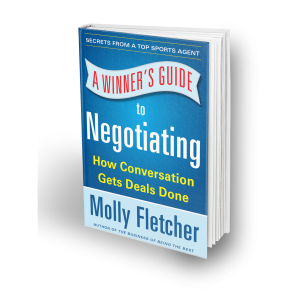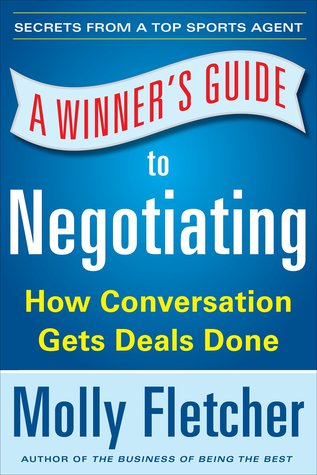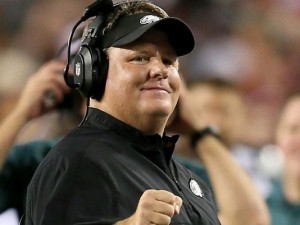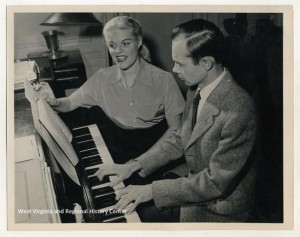Molly Fletcher's Blog, page 27
September 18, 2014
What Top Business Books on Negotiation Don’t Tell You (But I Will)
“Let us never negotiate out of fear,”  said former President John F. Kennedy. “But let us never fear to negotiate.”
said former President John F. Kennedy. “But let us never fear to negotiate.”
Fear is everywhere in business, and even the word “fear” can make us shudder. Overcoming fear is a huge part of negotiation.
A recent Salary.Com survey showed that nearly 60 percent of survey respondents said they dread salary negotiation. I felt strongly that we all (especially women) need tools to strengthen ourselves as negotiators, so I wrote a book that summarizes what I have learned in the sports, entertainment and media worlds.
Top business books promise success, but they don’t always address the underlying fears. Personally, I don’t think success is as likely without a direct look at the fears that hold us back. If you one of the majority that fears hammering out your salary package, how empowering would it be to turn your fear into confidence?
The reason I wrote “A Winner’s Guide to Negotiating: How Conversation Gets Deals Done” (McGraw-Hill) was to offer you a simple but powerful set of tools that will help you gain confidence as a negotiator right away. By practicing these tools, habit will override your fear.
A great need
No one majors in negotiation skills. Most of us learned the hard way, studying veteran deal makers and perhaps learning under their wings. There’s a dearth of quality teachers, reflected in results of surveys like Salary.com’s: most respondents said they learned whatever negotiation skills they have on their own, with no help from anyone.
If you’re reading this from an office or corporate setting, it’s highly unlikely that negotiating skills are part of your leadership training or professional development. That’s a shame, because I know from experience that negotiation is a skill that can be learned. It’s also something we do everyday, more than we sometimes realize, Creating awareness, fostering courage and applying tools to negotiation were all reasons to write this book.
Top business books fill gaps in knowledge, and that’s another reason for “A Winner’s Guide to Negotiating.” The same survey showed that 86 percent of respondents reported a desire to learn how to negotiate more effectively. They aren’t happy being afraid. There’s too much at stake!
What Fear Can Look Like
As a sports agent, I worked in a tight gap, between where elite performers shine, and where they want to—or could—go next. There are multiple layers and complexity to that space. Time may be the biggest factor.
For the top athletes, the window for them to excel is very short, and seizing that moment means everything. Payroll caps, free agency, the threat of arbitration, even trends like “money ball” are some of many other factors at play. Negotiating is at the heart of everything, and fear can be there too, believe me. There’s so much on the line that it’s easy for people to get anxious and defensive. Negotiators must stay open and responsive, and always observe and take in as much information as possible.
For 20 years I negotiated contracts and branding deals for 300 clients including top pro athletes, broadcasters, coaches universities, manufacturers, and teams. Together, I’ve done probably more than $500 million in deals—from a record-setting “ball, shoe, glove” deal with Nike, an appearance after Hall of Fame induction in Cooperstown or a multimillion dollar contract for pitcher John Smoltz, or multiple contracts for Cy Young winners, All-Stars, Hall of Famers, Emmy Award-winning broadcasters.
None of the deals are linear, and neither is the rest of life. As the mother of one and then twins born 12 months later, I’ve negotiated deals while standing on the sidelines of my kids’ soccer fields. As in parenting or any deep relationship, negotiating well means always being ready.
The most rewarding deals for me haven’t been the ones that are the most lucrative but rather the ones that change lives. Often the change is from fear to desire. Instead of dreading negotiation, I saw how a dialogue put everyone at ease and more open to finding a mutually satisfying agreement. Negotiation is about relationships, and relationships are about conversation.
The Importance of Belief
All the information in the world isn’t going to make a difference if you don’t believe it. Top business books are powerful because they have simplified and clarified the most difficult challenges. That clarity builds enthusiasm and confidence. My book is built around five core tools necessary for any successful negotiation. They are spelled out with personal anecdotes and are easy to grasp, and I believe you will be able to put them to work for you immediately.
The Takeaway
Before we negotiate with others, we have to negotiate with ourselves, and get a handle on our fears. Without that understanding, we cannot clear the way for success that is the aim of so many top business books.
Let me leave you with this inspiring thought from author Toni Morrison: “If there’s a book that you want to read, but it hasn’t been written yet, then you must write it.” That was one of my motivations, my drivers.
If there’s a goal that you want to reach, but it requires external support, then you must negotiate it. I know a top business book that can help
September 17, 2014
September 15, 2014
How To Ask For What You Want (And Get It) With These Negotiating Tips

Photo Credit: The National Learning Institute
Balancing trust and risk is necessary in every negotiation. This is a story that illustrates how striking this balance will help you ask for what you want and get it.
My three daughters—twins and a sister born within a year of each other—have the kind of teeth that look like a land mine went off in each mouth: teeth everywhere they shouldn’t be. In my area, braces go for $3,000 a kid.
I got to know the orthodontist, and her business operates like those of many entrepreneurs. She bills clients as the work is done, and enough clients pay in time for her to clear a profit. It’s important to study anxiety points like this. I saw what a pain it was for her office to track the records of every single kid and family and payer. That was a burden I was ready to relieve when we sat down to discuss our orthodontia game plan.
You might be thinking that no one negotiates with medical professionals such as orthodontists, but to me, anyone I do business with is in the business of negotiating. The orthodontist may not negotiate many deals like the one I was going to propose, but she’s already had to negotiate with insurance companies, suppliers, and who knows who else. All businesses do; the challenge is to draw a person into negotiating in an area that may be nontraditional.
She goes over what my girls need and quotes me $3,000 for each girl’s orthodontic work.
“What if I give you $6K up front for all three?” I counter. “It’ll be simpler for you to be paid in advance and not have to mess with any billing.”
She doesn’t think long. “Done,” she says.
And it was. I wrote the check, and my girls are getting their teeth straightened.
Key negotiating tips
My counteroffer illustrates these important steps:
Setting the Stage: I knew the typical cost (the “comp”) for the service I needed. I had done my homework on what I should expect to pay. This was my baseline. I had scouted out how her business operated.
Finding Common Ground: People faced with complexity are attracted (generally) by simplicity. The orthodontist would save work by accepting my offer for less cash. Essentially we were working together for a common goal of simplifying our transaction. Note that this deal involved a good bit of trust from me that I wouldn’t get screwed on service, that this orthodontist wasn’t going to leave town before the job was done. I bet against that on the basis of her reputation. She knows, too, that a great deal for me can result in intangible marketing benefits as I advertise her among my deep base of neighbors and clients who are connected through social media. Part of our deal involved her being able to take before and after photos of my daughters’ teeth. Finding Common Ground often can lead to discovering win-win scenarios like this.
Asking With Confidence: I was precise ($6K) and concise (just a couple of sentences). Talk as much as you need to, but no more. The more concise you can make your ask, the more confident you will become. Fewer words means less margin for error; this takes practice.
The takeaway
I was able to Ask with Confidence because my trust was high. The higher the risk of the ask, the more trust you need before you can Ask with Confidence. There has to be enough trust that you truly believe in what you are asking for enough to overcome any doubt that it is worth asking for. Confidence comes from a place of safety and trust, both of which can be established through Setting the Stage and Finding Common Ground.
Molly Fletcher helps inspire and equip game changers with the negotiation tactics for leading well and with purpose. This blog is excerpted from her new book, “A Winner’s Guide to Negotiating: How Conversation Gets Deals Done” (McGraw-Hill), which draws on her decades as a sports agent and negotiator on behalf of pro athletes, coaches and broadcasters. Please sign up for our newsletter or follow Molly on Twitter @MollyFletcher for additional negotiating tips.
September 12, 2014
Enter to Win a Free Copy of Molly’s New Book from Goodreads
Please visit the Goodreads link below for your chance to win a free copy of Molly’s new book “A Winner’s Guide to Negotiating: How Conversation Gets Deals Done” (McGraw-Hill), which will be in stores on September 19.
Goodreads Book Giveaway

A Winner’s Guide to Negotiating
by Molly Fletcher
Giveaway ends September 15, 2014.
See the giveaway details
at Goodreads.
September 11, 2014
Negotiation Strategies: Embracing the Power of Pause

Photo Credit: Andrew Schultz
Thirteen years ago, after terrorists struck our country, life became still. Flights were grounded, and because I live near one of the world’s busiest airports, the sound of silence was particularly strange.
In that pause, the “new normal” began. No plane flight was ever the same. New security and rules changed all of our old patterns. After the 9/11 attacks, Americans took space and time to sort out what had happened and what needed to be done. That pause changed life as we knew it.
That’s also true in negotiation strategies. An important lesson for negotiators is to embrace the pause and not try to fill it.
Tactical silence as a negotiation strategy
More often than not, no matter how well the negotiations are going, there will be a point when you reach some sort of stalemate. You might be just short of a breakthrough but the sides haven’t been able to reach mutually agreeable deal points. Now is the time to embrace the pause.
Embracing the pause may look like doing nothing, but in reality you are tapping into s deep power. In reality, pausing to “do nothing” is doing everything to help you negotiate.
Pausing allows you to listen, and when you listen, you learn.
Get comfortable with ambiguity
Most of us feel uncomfortable with dead zones in conversation. A conversation (and that’s what a negotiation boils down to) is like a tightrope stretched between two people. Silence makes you look around for the net, some sort of signal that we are still in communication and nothing has gone wrong.
We don’t like ambiguity. It’s a big vacuum and we try to fill it. In a conversation or negotiation, silence can signal ambiguity. By mastering the art of quiet, we give others every chance to help us.
The storyteller’s tool
Storytelling is a great asset in negotiations. A storyteller uses the pause to build suspense. The more tension you have, the longer the pause can be, and the more satisfying the end needs to be for the audience.
Rushing through details in a story can often confuse the listener and make a punch line hard to get. Don’t be afraid to slow down and, at the critical moments, stop completely.
The takeaway
In negotiations, the moment of quiet between the ask and the answer is a chance to think and reflect. If you embrace the pause, you often will control the negotiation because you send the message that you are very comfortable with yourself and your negotiating position. Pausing can seem uncomfortable, but when you make it a habit, you are using a tool that the best negotiators rely upon.
Embracing the Pause and other powerful negotiation strategies are explored more fully in Molly Fletcher’s new book, “A Winner’s Guide to Negotiating: How Conversation Gets Deals Done” (McGraw-Hill), which will be in stores on September 19. Her expertise draws on her decades as a sports agent and negotiator on behalf of pro athletes, coaches and broadcasters. Follow Molly on Twitter @MollyFletcher.
September 8, 2014
Need To Inspire A Struggling Team? Top Motivational Speakers Like Chip Kelly Use Honest Humor

(Photo: Rob Carr Getty Images)
The Philadelphia Eagles seemed like they couldn’t do anything right in their first game last weekend, and head coach Chip Kelly heard the fans booing too. The team was losing 17-0 at halftime to Jacksonville, a team that only won four games last year.
Here’s rare honesty: “I was booing myself,” Kelly said after the game.
The final score proved that candor is such an important asset for top motivational speakers. Under Kelly’s leadership—and halftime message of support the Eagles’ double downed on the booing and ended up winning the game easily (34-17; Jacksonville never scored again).
Kelly is one of the most candid coaches in pro sports. His players and the Philly fans like him because he tells it like it is. Likeability, respect, and sincerity work together to effectively carry a motivational message.
Success as a Motivational Speaker
A coach at this level is first and foremost a motivator. Strategy and talent mean little if the team is not motivated. With motivation, a team can overcome almost anything.
Kelly’s career shows this. He arrived after the Eagles won only four games in 2012 and lost 12. He turned that around immediately. In 2013, his first season, the team won 10 games and their division championship, and lost their first playoff game on a last-second field goal.
But that was so last season. Last weekend, Kelly had to motivate the Eagles at halftime against Jacksonville.
“We weren’t throwing chairs or anything during halftime,” he said. “It was just, ‘Hey, settle down.’ ”
The message was simple and powerful. His team had prepared well, but they still had to execute. He reinforced that message by sticking with the starting quarterback, who responded to Kelly’s vote of confidence with a vastly better second half.
Honesty and Humor
Honesty builds credibility; humor brings likeability.
Kelly was brutally honest when asked to grade his coaching performance his first season in Philadelphia. “I give myself a 58.8 percent,” he said, referring to the team winning 10 of 17 games.
When he was a college coach, he was known for clever, memorable insights (Google “Chip Kelly funny quotes” and you’ll get 113,000 results).
After one loss, he said, “I saw the ‘Feel Sorry for Yourself’ train leaving the parking lot and none of our players weren’t on it, so that was a good sign.’”
Finding humor in situations that are full of stress and uncertainty can help your team feel less pressure and see their positives.
The takeaway
When employees, especially your direct reports, perceive you as a straight shooter, they are more likely to respect you—even if they are struggling, and even if what you must tell them is hard to hear.
If you pair that honesty with a sense of humor, you have key traits of a top motivational speaker, as modeled by Chip Kelly:
He has an inspiring message that uses humor that he is not afraid to aim at himself.
He uses inspiration and humor to ignite behavioral change.
He injects his audience with the energy to improve their performance.
Molly Fletcher is an author, consultant and motivational speaker who helps business teams improve relationships. Her book, “A Winner’s Guide to Negotiating: How Conversation Gets Deals Done” (McGraw-Hill), will be published this month and draws on her decades as a sports agent and negotiator on behalf of pro athletes, coaches and broadcasters. Please click here to contact Molly.
September 5, 2014
Creating a Business Development Plan: Transform Key Relationships With 3 Tested Strategies

SmallBiz Technology
Whether or not your job title suggests you are in a business development role, you probably are! That’s the reality of our business world today. Our success and growth depends on relationships. This could be with a key client or supervisor, or a mentor. We can know that this is important, and even think that we are nurturing these important bonds, but most of us are not intentional enough.
Today I want to share a quick exercise that can be part of your business development plan and help you be more intentional about building and managing relationships. Working as a sports agent, I quickly realized the edge gained by taking raw connections and nurturing them into meaningful, sustaining relationships.
Here are three strategies that you can assess and intentionally transform your business relationships. It’s a simple exercise that I use often because time and time again, it’s worked. Even if you feel confident about this part of your business development plan, test your assumptions with these quick steps.
Strategy 1: What’s in Your Favor Column?
Brainstorm 10 ways that you can help your most important business contacts—those you already have and those you want to gain. Some examples of favors include:
Introducing them to a person in your circle who can help them in some way.
Forwarding industry-specific news or leads that is valuable; look for sources that your contact is not tapping.
Pointing them to books and articles that could advance their goals.
Providing knowledge, access or assistance that they cannot easily secure otherwise.
The more you think in terms of sharing assets and building a Favor Column, the more your empathy will guide your thoughts and actions , and that will project positivity to your key person. Remember that this is not about your gain, but theirs.
Strategy 2: What Are Your Stories?
Identify 10 stories from your experience that showed how you made an important difference to your company’s or client’s goals.
Think of moments when you shone, when your unique abilities and attributes made your team greater than the sum of its parts. You may have solved a difficult problem, found a new way to collaborate, or managed to deliver on a tight deadline.
Be as specific and detailed as possible with these anecdotes. “I made my sales quota,” is bland; “I increased my client’s portfolio by 40 percent, and in target markets that increase was 60 percent,” is way better.
These stories are your means and your message. You’re not selling anyone anything; you’re merely telling them facts of your past experience that can help them get where they want to go.
Strategy 3: Who Will You Pursue?
List five relationships you want to improve. These names will go in one column. In the second column, note whether you have provided so much value to this person that they “owe” you. If the answer is yes, put a plus sign (+) in this column. If the answer is no, put a minus sign (-).
For every relationship that is followed by a (-), write down:
One specific way you can add value to this person.
One story you could share authentically that would resonate with this person’s goals, desire and mission.
For every relationship that is followed by a (+), write down:
Is there an introduction that this person can make for you? To whom?
How and when will you make the ask?
The takeaway
Be intentional about how you incorporate relationship-building skills into your business development plan. These partnerships don’t just happen.
Take stock of what you specifically can offer a key client or prospect, and map out the best way to leverage your unique assets. Use these strategies and don’t be surprised if you become an indispensable ally to those who can help you the most.
Molly Fletcher helps men and women in business build better relationships . Her book, “A Winner’s Guide to Negotiating: How Conversation Gets Deals Done” (McGraw-Hill), will be in stores September 19 and draws on her decades as a sports agent and negotiator on behalf of pro athletes, coaches and broadcasters. Follow Molly on Twitter @MollyFletcher.
September 2, 2014
Big Auction Shows How Negotiation Skills Pay Off
A recent story about an  extraordinary auction of personal memorabilia collected around the world reminded me how great negotiators position themselves for their biggest deals. They build off smaller deals first, gaining knowledge, skills and trust of the other side that lead naturally to bigger stakes.
extraordinary auction of personal memorabilia collected around the world reminded me how great negotiators position themselves for their biggest deals. They build off smaller deals first, gaining knowledge, skills and trust of the other side that lead naturally to bigger stakes.
Negotiation skills on display at a big auction
You can get a great look at negotiation skills at an auction, where the atmosphere and agendas of the participants often create a bidding frenzy.
Recently there was a huge auction of antiques and books collected by a globetrotting opera singer named Frances Yeend and her husband James Benner. This news story describes how the couple’s vast inventory of valuables were auctioned off by the same negotiator who helped assemble some of the collection in the first place.
Some background: after Yeend died in 2008 at age 95, Benner (who is now 89) didn’t want family members burdened with unwanted items after he was gone. We’re talking enough stuff to fill a six-room apartment in New York and a home in West Virginia that the couple enlarged four times.
Benner approached several big New York auction houses, but negotiations fell apart when shipping the items to the Big Apple would be a major headache. So Benner looked back home, to a trusted local source who had sold him many valuable pieces: auctioneer Joe R. Pyle.
A lengthy, strong relationship
The Yeend-Benner collection was a huge windfall for Pyle and his firm because auctioneers typically earn a sales commission from the seller. According to the news report, Pyle estimated up to 3,000 lots would be up for sale, some having up to 50 items. The collection includes glassware, furniture, pottery, Persian rugs, ivory, and paintings stretching back to the 16th century.
“This is a landmark collection, the likes of which we may never see again,” Pyle said in a news release. “There are things in this auction that are going to surprise even the most jaded collectors.”
Before he could negotiate on behalf of the Yeend-Benner collection, he had to prove himself as a trustworthy auctioneer. By handling the first stage well for his clients—getting some of those precious items into their collection—Pyle earned the trust to handle the far more lucrative last deal. It was his company’s biggest auction ever.
“When Mr. Benner and Ms. Yeend were still actively collecting, they …developed a good relationship with Joe, and Mr. Benner knew he’d be able to bring a nice price for their items,” Jared Shinn, director of marketing and operations for Pyle’s auction house, told the Charleston Gazette. “That established relationship from the past led Mr. Benner to come back.”
Your professional standards may dictate proof of your integrity. In this example, West Virginia requires auctioneers to be licensed, and everything that is sold must have a receipt with the auctioneer’s name, license number and permanent address. Even if this is not required for your industry, are you willing to take responsibility like that for your clients and prospects?
The takeaway
The seeds of your next negotiation are being planted in the one right now. Integrity is the starting point for building trust. Trust consists of credibility (fostered through honest communication and meaning what you say), reliability (created by following through on commitments) and connection (demonstrated through empathy and nonverbal communication that you are willing to trust and are worthy of others’ trust).
Standing behind your negotiations in an authentic way creates trust that can open more doors for bigger deals in the future.
Molly Fletcher helps inspire and equip game changers with the negotiation tactics for leading well and with purpose. Her book, “A Winner’s Guide to Negotiating: How Conversation Gets Deals Done” (McGraw-Hill), will be published this month and draws on her decades as a sports agent and negotiator on behalf of pro athletes, coaches and broadcasters. Contact Molly here.
August 28, 2014
The Art of Negotiation Part II: The Kevin Durant-Under Armour Offer and Relationship Building

Wikimedia Commons/Image
Kevin Durant’s reported $265 million plus offer from Under Armour illustrates how important relationship building is when you’re negotiating. After reading reports from ESPN and other media, I was impressed with the way Under Armour understood the story of the NBA’s most valuable player, and offered him value that goes beyond dollars.
As with LeBron James’ return to Cleveland, the negotiation process is fascinating, especially one that is under such incredible scrutiny. In particular, here’s what negotiators can learn about relationship building from the Durant offer:
Set the stage by understanding existing key relationships. Under Armour understood Durant’s close ties to his mother. When he won the MVP award, he thanked his mother for pushing him through hard times: “You kept us off the street. You put clothes on our backs, food on the table. When you didn’t eat, you made sure we ate. You went to sleep hungry. You sacrificed for us. You the real MVP.” Under Armour’s package includes a community center built in Durant’s mother’s name—a way to honor such an important person in his life. A building will stand well after Durant retires, with the potential for supporting other families like Durant’s.
Find common ground. Under Armour is a Maryland company, based 30 miles from Durant’s boyhood home. The company regularly invests in the community. The idea of “keeping it local” appealed to Durant. The proximity helped Under Armour take a big risk. The company has never committed to a sponsorship deal of this size. It’s reportedly nearly 10 percent of its current annual marketing budget. Even if Nike matches the deal and keeps Durant, the offer is a shrewd way for Under Armour to grab headlines about where it wants to go in this sport—by reaching out to a neighbor. Relationships to places, not just people, are important.
Ask with confidence, even if the numbers aren’t specific. ESPN reported that Durant visited Under Armour headquarters “and was said to be blown away by its pitch [which] didn’t include talk of specific numbers, but impressed Durant with attention to detail about his life, the hometown flair and return on investment of its stock, which would make up part of Durant’s compensation.” If you have set the stage well and establishing common ground, the ask is an invitation to take a strong relationship to a new level. It’s a natural extension of what has come before.
The takeaway
Negotiators understand existing loyalties and build on them by setting the stage and finding common ground. They can ask with confidence because they have calculated the risks. Under Armour is an excellent example of this strategy. Durant was one of Nike’s most loyal athletes, rejecting an offer by Adidas that was more than $20 million higher to sign with Nike. Like Nike before it signed Tiger Woods, Under Armour has a very small basketball business. This is a major play to raise its profile in this sport to a never before seen level.
Molly Fletcher helps inspire and equip game changers through skills such as building better relationships. Her book, “ A Winner’s Guide to Negotiating: How Conversation Gets Deals Done ” (McGraw-Hill), will be published in September and draws on her decades as a sports agent and negotiator on behalf of pro athletes, coaches and broadcasters. Contact Molly here.
August 20, 2014
When the Stakes are High, Use Steve Ballmer’s Epic Negotiation Tactics

Photo Credit: AP Photo
It hasn’t been easy loving the Los Angeles Clippers, and when the team’s new owner, Steve Ballmer, introduced himself last week, he had many hearts and minds to win over.
Until recently, the team was a losing franchise, and then their previous owner got banned from the league for racial remarks. Ballmer wasn’t just introducing himself; he was in effect negotiating with the fans to get behind his team in a big way.
The stakes are big, because both have a lot invested in the Clippers. And the way Ballmer (the former CEO of Microsoft who bid $2 billion for the Clippers) jumped into this role answered the key questions that drive successful negotiation tactics.
Do I like you?
“I love basketball,” Ballmer proclaimed from the get-go of his speech at a rally of Clippers fans. He whipped a bright blue Clippers towel, shouted, sweated and paced like a tiger. He put his passion out there. Passion is the driver for fans of any team, so in those three opening words Ballmer connected to what they love, too.
He drove this point home later in his speech by reading a letter from a longtime fan who said his success in law school was inspired by the Clippers’ work ethic and desire to come from nothing to become something. Underdogs are likeable, and Ballmer used a wise negotiation tactic to align himself with the fans’ David v. Goliath attitude.
This is what I call determining the inner baseline. Understanding the motivations of the other side, as well as your own, will open more choices, which create more engagement and willingness in negotiation.
For the vast majority of the people he’s trying to reach, Ballmer is awful hard not to like. He opens his heart and most people fear doing that. He’s also funny, and most of us love to laugh.
Can you help me?
Yes, and in a big way. Ballmer read out his email address and told fans to call him Steve. That’s an invitation to an uncommon level of access and intimacy to a guy with that much power.
Beyond those specifics, Ballmer also outlined a clear new direction and values for the team. His leadership of the Clippers would be based on openness, respect, boldness, risk taking, optimism (“a force multiplier,” he said, quoting Colin Powell) and tenacity (“We are going to keep coming and coming and coming… nothing gets in our way! The hardcore Clippers, that’s us!”)
Ballmer gave fans his reason and method for helping the team and fans start over after the recent scandal.
Do I trust you?
You could see that question in the faces of the Clipper players who were lined up on the stage with Ballmer: Is he for real?
Ballmer knew he had to answer that, and other more specific issues the fans had. He quickly answered a question that was in many minds about possibly taking the team to his hometown: “I’m not moving the Clippers to Seattle,” he announced early in his talk.
It wasn’t just what he said, but how. On a scale of 10, Ballmer’s enthusiasm, decibel level and authentic smile were at 11 the whole time he was on stage. A smile encourages the audience to smile back. An authentic smile conveys humanity and humility. Ballmer’s authentic smile commanded authority and invited trust.
“I love this team!” he yelled. And when the crowd response didn’t match his, he pushed them for more.
Some people watch this clip to laugh at Ballmer, but I think the reason that his speech went viral is because they like him. He’s not the buttoned-down businessman, but a big guy with a lot of guts to put himself out there and not worry about what other people think of his style. Ballmer is authentic and vulnerable, two building blocks for trust.
The takeaway
Trust between a billionaire and a beleaguered NBA fan isn’t going to happen instantly. It was noticeable, though, that in the course of his speech his players’ faces changed from quizzical and embarrassed to confidence and even pride. As they listened and watched an invitation that was clear, concise and passionate, they were getting on Ballmer’s side. The crowd of fans reaction grew as well.
Time will tell if Clippers fans like him, if he helps them and if he is worthy of their trust—three issues that are key to setting the stage for negotiation. His actions, far more than his words, will continue to determine those answers.
Watching his negotiation tactics, I’m expecting Ballmer’s success.
Molly Fletcher helps inspire and equip game changers with the negotiation tactics for leading well and with purpose. Her book, “ A Winner’s Guide to Negotiating: How Conversation Gets Deals Done ” (McGraw-Hill), will be published in September and draws on her decades as a sports agent and negotiator on behalf of pro athletes, coaches and broadcasters.



